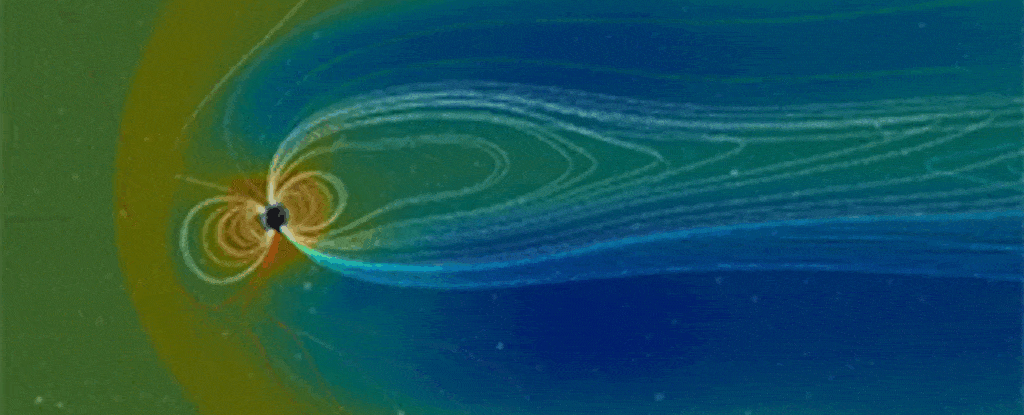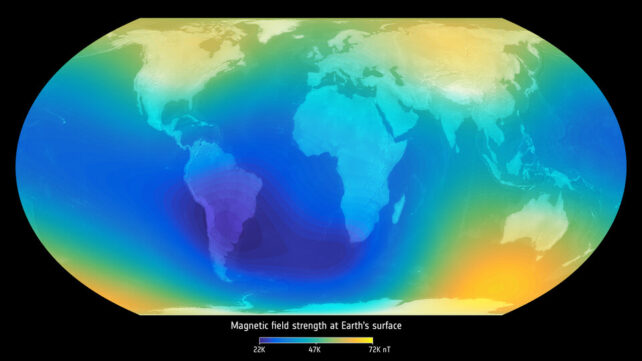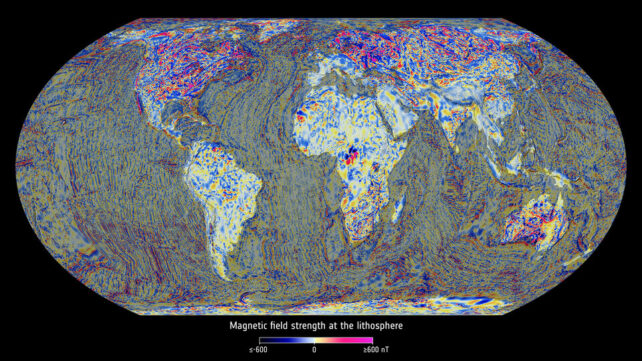
Over 40,000 years ago, Earth’s magnetic field underwent a significant reversal. Modern researchers have been able to study this remarkable phenomenon through innovative analysis of data obtained from the Swarm satellite mission conducted by the European Space Agency.
By integrating satellite observations with records of magnetic line shifts on our planet, European scientists have successfully reconstructed the Laschamps event, illustrating it with natural sounds, such as creaking wood and colliding rocks.
This unprecedented auditory representation was revealed in 2024, created collaboratively by the Technical University of Denmark and the German Research Center for Geosciences.
Earth’s magnetic field, generated by the movement of molten metals in the core, extends thousands to hundreds of thousands of kilometers into space, acting as a shield against harmful solar particles that could strip our atmosphere.
Currently, the field lines create closed loops traveling from south to north above the Earth’s surface and reversing direction deep beneath it. However, this magnetic orientation is not permanent; at times, the field undergoes a spontaneous polarity flip. If this were to occur today, compasses would point toward the South Pole instead of the North.

The most recent major magnetic event happened around 41,000 years ago, leaving an imprint in the Laschamps lava flows located in France. This period was marked by a decrease in the magnetic field’s intensity to merely 5% of its present strength, allowing a greater influx of cosmic rays into Earth’s atmosphere.
Evidence of this increased solar radiation is stored in ice and marine sediments, which show a doubling of beryllium-10 isotopes during the Laschamps event, as detailed in a study published last year.
These isotopes result from cosmic rays interacting with our atmosphere, leading to ionization and damaging the ozone layer. This phenomenon might have contributed to global climate changes, potentially correlating with the extinction of Australia’s megafauna and alterations in human cave usage, as suggested by prior research.
“Grasping these extreme occurrences is vital for forecasting future events, predicting space climate changes, and evaluating their impact on the environment and Earth’s systems,” explained Sanja Panovska, a geophysicist from the German Research Center for Geosciences.
This magnetic reversal process took approximately 250 years and lasted in its peculiar orientation for around 440 years. During this time, the Earth’s field may have dropped to as low as 25% of its current strength, with the magnetic north migrating toward the south.

Recent anomalies in the magnetic field, like the weakening over the Atlantic Ocean, have sparked discussions about the possibility of a contemporary reversal. However, new studies indicate that these anomalies may not be indicative of such events.
While the South Atlantic Anomaly is currently exposing satellites operating in that region to enhanced radiation levels, it is important to note that it does not necessarily predict an imminent magnetic reversal.
Since 2013, the ESA’s Swarm mission has been diligently measuring magnetic signals emanating from Earth’s core, mantle, crust, oceans, ionosphere, and magnetosphere. This ongoing research aims to deepen our understanding of the geomagnetic field and anticipate its changes.
This article was initially published in October 2024.









